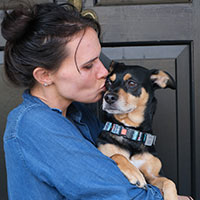Trigger Warning
Let’s begin with a question. Have you ever tried to tell someone a story in the hopes that they stay? It doesn’t matter if it’s a lie or a promise, the end is usually the same: if you have to tell them a story, they have already gone.
That’s where Couri Johnson’s latest collection, Love Breaks My Bones, and I Laugh, begins: after the beloved have already left. In eight short stories, this novella-length work moves within (and outside of) the fabulism Johnson is known for. It re-tells The Ice Queen in “A Shard” and uses “Ma,” a tale of unwanted gifts, to discuss how chivalry isn’t dead but was always a burden. Contiguous throughout all of these stories are the speaker/s that reside in adult fantasy. These protagonists live in the lies we tell ourselves to survive. They will come back. This time it will be different. I am not a hypocrite.
Fans of Johnson’s work, namely her previous collection I’ll Tell You a Love Story (Bridge Eight, 2020), might notice an anger in these stories that felt more subdued before. There is a pain that still burns—the hand pressed to the stove, a flash in the sear that has not subsided. A kind of frenetic energy carries the reader through these pieces: “A feeling like her eyes were closed and she was searching for something hard and stable within herself and coming back with only a puddle, damp and easily stirred, dissipating. Because there is a feeling, a feeling of reaching” (58). These stories encapsulate the want, and the shame of the want, and the cover that tries to ignore the shame, and the want, and the want, and the want. We can feel that familiar pull prying our eyes open, forcing us to look. This is pain, Johnson suggests. Isn’t it beautiful?
In this medium, Johnson forces us to ask questions of ourselves, like the fact that we can’t stop looking. What does it mean that female pain is so easily consumable? Does culpability for this voyeurism lie in the speaker/s, author, or reader/s? In communal culpability, have we finally found a way to not be alone?
And this desire to not be alone bleeds into the poetics of the pieces. That is, this multiplicity is crucial to the collection as a whole. The collection could be both one and many narrators, who may or may not also be the character/s or the author herself. Inasmuch as the borders between “I” and “you” feel definite, the stories call into question other permeabilities between speaker, author, and reader. The metafictions of “Possible Dedications for My Next Short Story Collection” or “Rewrites” allow readers to see the seams, just as the perceived alignment between speaker/s (or was it author) and Hans Christian Andersen reaches forward and backward in longing that supersedes linearity. “It was in the past, but also, it is always happening to her. She has trouble, sometimes, staying accurate, keeping track of time. She has to write it all down” (29). The imagination is layered, much like time, and always with more than a hint of the possible: “This is not a story, she tells him. Not yet, the crow says” (31). Perhaps possibility is also a threat.
Make no mistake, the world you’ll find between these pages is threatening. In fact, one might consider whether Johnson’s collection at its core interrogates what happens to love during the ongoing apocalypse/s — a work that acknowledges humans are not enough.
Because you cannot read these stories without considering human fallibility. And Johnson plays with this: “That’s not true, actually. Sometimes I have a problem with lying. It isn’t good to be too honest too quickly, I’ve learned that” (51). Perhaps, we fear, what makes us human is the very thing that makes us unlovable, or rather, that we are told makes us unlovable. But then again, weren’t you supposed to love our flaws?
This collection is what happens when the foundations beneath crumble, when we find we are standing on sand and the hurricane comes and it pours through our fingers. How can we be mad at the sand for being sand? Or really, what is the use?
These are not questions these stories seek to answer because there are no answers. Such questions obfuscate the truth, which is angry or not, useful or not, the sand won’t stop the flood from eroding our feet. Protagonist or not, we still drown in the end.
And that’s what this book is about: drowning. These are the kinds of fables you tell at the end of the end of the world. “The city grows, the plants recede, and no one, not a single soul, loves the sight of a maggot even though they are often the last scrap of nature we have left” (54). Some, yes, have known that the world was ending for quite some time. Perhaps others have only recently noticed the waters’ rise.
So come, stand on the edge with me. Sate your want in the dissolve, and let the ocean lap at your feet.
